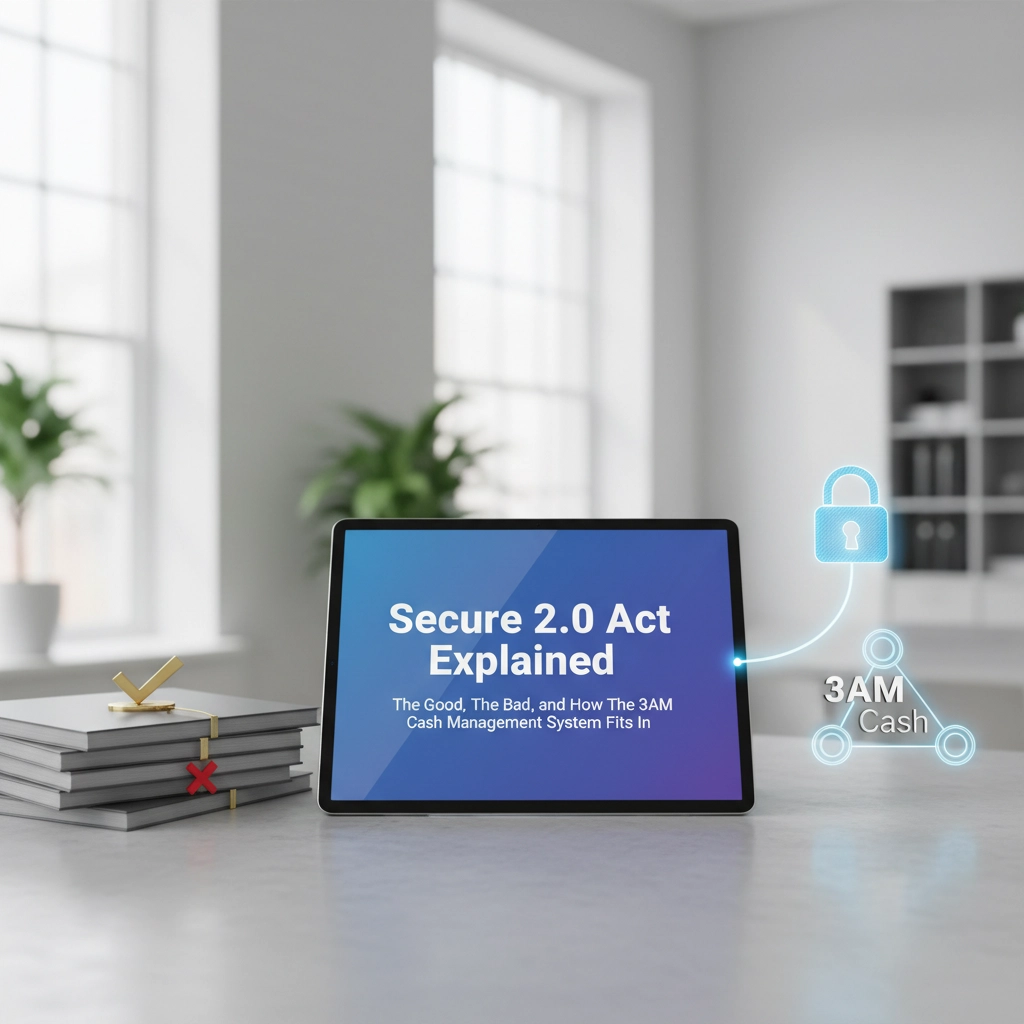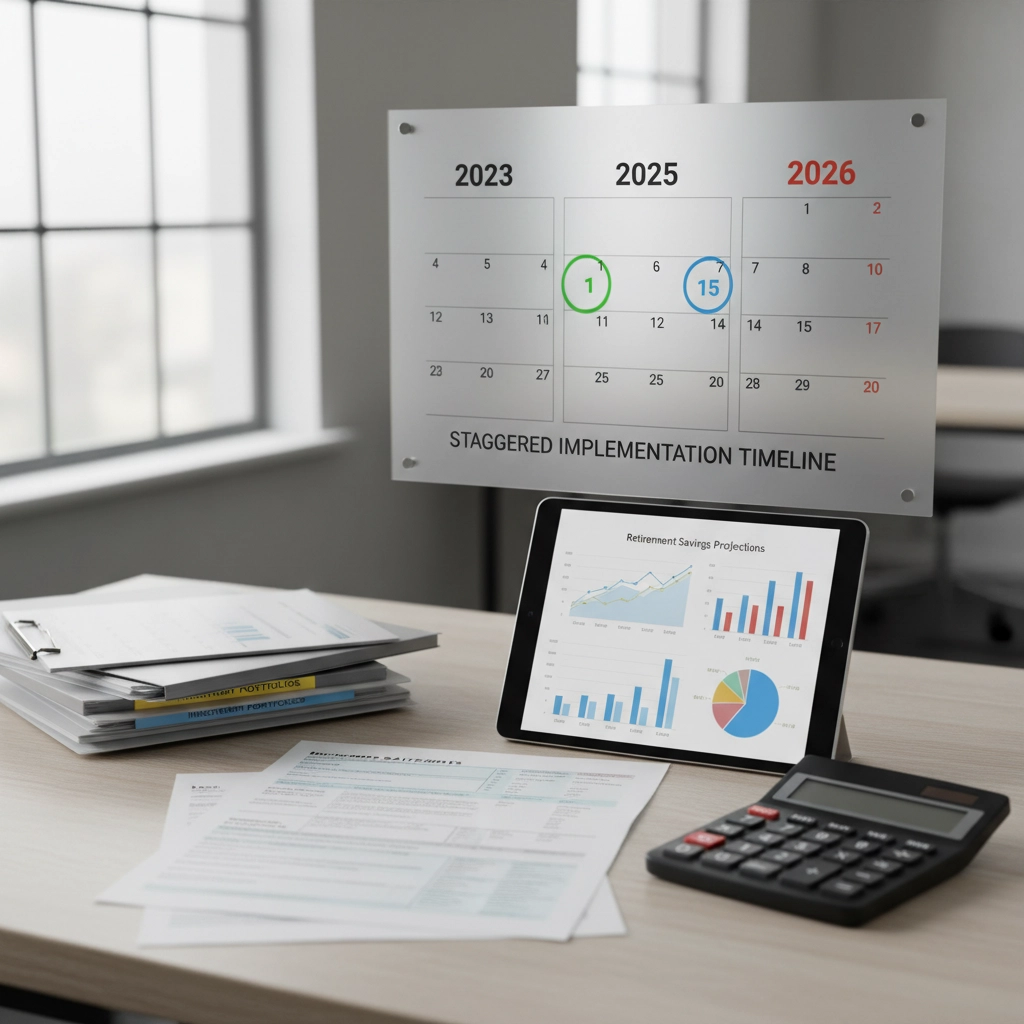
SECURE Act 2.0
Secure 2.0 Act Explained: The Good, The Bad, and How The 3AM Cash Management System Fits In

The Secure 2.0 Act might be the most significant retirement savings legislation you've never heard of. Signed into law in late 2022, this comprehensive reform package includes over 90 provisions designed to help Americans save more for retirement. But like most government legislation, it's a mixed bag of opportunities and challenges that could either supercharge your financial future or create new headaches if you're not prepared.
Whether you're managing household finances, running a business, or overseeing a nonprofit, understanding these changes is crucial. More importantly, knowing how to navigate them with the right systems in place can make the difference between stress and financial clarity.
What Exactly Is the Secure 2.0 Act?
The Secure 2.0 Act builds on the original SECURE Act of 2019, introducing sweeping changes to retirement savings rules. Think of it as a massive update to how 401(k)s, IRAs, and other retirement accounts work. The legislation aims to increase retirement plan participation, boost savings rates, and give Americans more flexibility in their retirement planning.
But here's the catch: these changes roll out over multiple years, with some taking effect in 2023, others in 2025, 2026, 2027, and beyond. This staggered timeline has created confusion for both employers and employees trying to understand what applies when.

The Good: Real Opportunities to Build Wealth Faster
Higher Catch-Up Contributions for Your Peak Earning Years
Starting in 2025, if you're between ages 60-63, you can contribute an extra $11,250 to your 401(k) beyond the standard limits. That's significantly more than the current $7,500 catch-up contribution for those 50 and older. For many people, these are their highest-earning years, making this the perfect time to accelerate retirement savings.
Automatic Enrollment Removes Decision Paralysis
All new 401(k) and 403(b) plans must automatically enroll eligible employees, starting contributions between 3-10% of salary and increasing by 1% annually until reaching at least 10%. This simple change addresses one of the biggest barriers to retirement savings: people simply not getting started. You can still opt out or adjust your contribution level, but the default is now to save.
Part-Time Workers Get Better Access
The eligibility requirement for part-time workers dropped from three years to two years of service with at least 500 hours worked annually. This opens retirement benefits to millions of Americans in non-traditional work arrangements who were previously left out.
More Time Before Required Withdrawals
Required minimum distributions (RMDs) now start at age 73 instead of 72, and will increase to age 75 in 2033. This gives your money more time to grow tax-deferred. Plus, if you mess up and miss an RMD, the penalty dropped from a crushing 50% to 25%, and down to just 10% if you fix it quickly.
Expanded Roth Options Everywhere
Small business owners and self-employed individuals can now contribute to Roth versions of SIMPLE IRAs and SEP plans. This means more people can access tax-free growth in retirement, regardless of their employer's plan structure.
The Bad: Complexity and Potential Pitfalls
Implementation Is a Nightmare
With 90+ provisions taking effect across different years, even financial professionals are struggling to keep track. The IRS extended the amendment deadline to December 31, 2026, but employers still need to comply operationally as changes take effect. This creates confusion and potential compliance issues.

High Earners Lose Flexibility
Starting in 2026, employees earning over $145,000 must make all catch-up contributions to a Roth account (after-tax). While Roth accounts are generally beneficial, this removes the choice for high earners who might prefer the immediate tax deduction, especially if they expect to be in lower tax brackets during retirement.
Automatic Enrollment Creates Employer Burdens
While automatic enrollment helps employees, it places new compliance requirements on employers. They must manage enrollment processes, contribution escalations, and opt-out procedures. Small businesses with 10 or fewer employees are exempt, but others face increased administrative costs and potential fiduciary liability.
Tax Timing Could Backfire
Delaying RMDs until age 75 sounds great, but it means larger required withdrawals over fewer years. This could push retirees into higher tax brackets when they finally start taking distributions, potentially resulting in higher lifetime taxes despite the delay.
How The 3AM Cash Management System Leverages These Changes
Here's where strategic cash flow management becomes critical. The Secure 2.0 Act creates opportunities, but only if your overall financial system can support them.
Maximizing Contribution Opportunities
The 3AM Cash Management System helps you identify exactly how much you can afford to contribute to retirement accounts without disrupting your daily cash flow. With higher contribution limits and catch-up provisions, you need a clear picture of your monthly cash position to take full advantage.
Instead of guessing whether you can afford to increase your 401(k) contribution, the system shows you precisely where your money goes and where you have capacity for additional savings. This is especially crucial for the new super catch-up contributions if you're between 60-63.

Navigating Roth vs. Traditional Decisions
With expanded Roth options and mandatory Roth catch-ups for high earners, you'll face more complex tax decisions. The 3AM System helps you understand your current tax situation and cash flow patterns, making it easier to decide between immediate tax deductions (traditional) and tax-free growth (Roth).
Planning for Automatic Enrollment Changes
If your employer implements automatic enrollment with annual increases, you need a system that can accommodate changing contribution levels without disrupting your budget. The 3AM approach ensures your baseline expenses are covered first, so automatic increases enhance your savings rather than create cash flow problems.
Preparing for Future RMD Requirements
While RMDs are delayed, they're not eliminated. The 3AM System helps you build cash reserves and plan for the eventual larger distributions you'll need to take. By managing your cash flow efficiently now, you can prepare for the tax impact of concentrated distributions later.
Real-World Application: Making It Work for You
Whether you're managing household finances, running a business, or overseeing a nonprofit, these Secure 2.0 changes affect your cash management strategy. The key is having a system that adapts to these regulatory changes while maintaining your financial stability.
The most successful approach combines understanding the new rules with implementing proven cash management principles. This means knowing what you can contribute, when you should contribute, and how these decisions fit into your overall financial picture.
Take Control of Your Financial Future
The Secure 2.0 Act presents both opportunities and challenges, but the biggest risk is doing nothing while these changes roll out around you. The complexity of the new rules makes it more important than ever to have a clear, systematic approach to managing your finances.
Ready to see how these changes can work in your favor? Join the Financial Freedom In 40 Minutes Masterclass for friendly, step-by-step guidance to set up a cash management system that adapts to new rules while building long-term wealth—no more guesswork or stress.
Whether you're running a church, nonprofit, business, or managing your household, you'll walk away with:
Simple, repeatable steps you can implement today
A month-by-month plan for cash flow clarity and control
Confidence to choose Roth vs. traditional contributions
Practical tips for handling automatic enrollment and future RMDs
Register for The Financial Freedom In 40 Minutes Masterclass →
The Secure 2.0 Act isn't going anywhere, but your opportunity to get ahead of these changes and position yourself for financial success is happening right now. Take action while you still have time to implement the right systems and strategies.
